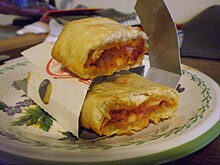Susceptor

A susceptor is a material used for its ability to absorb
Operation
In
- Conduction heating occurs with good thermal contact between the susceptor and food. Because of the lower temperatures there is less browning, but more than if there were no susceptor at all.
- If there is an air gap (or at least, poor thermal contact) between the susceptor and food, the susceptor will heat to a much higher temperature (due to its smaller effective heat capacity when in poor contact with food), and, at these higher temperatures, will radiate strongly in the infrared. This infrared radiation then shines onto the food below or next to the susceptor, causing a "broiling" type effect (high skin heating) due to lower ability of infrared to penetrate foods, vs. microwaves. Conversion of some microwave energy to infrared is particularly useful for foods which require a large amount of crust-browning from infrared, such as frozen pies.
Design and use
Susceptors are usually made of metallised film, ceramics or metals (such as aluminium flakes).
The susceptor (which may be located on examination by its gray or blue-gray color, which is different from paper) is the reason products meant to be browned via susceptor-generated thermal radiation carry instructions to microwave the food while still inside its packaging.
Susceptors meant to heat foods by direct conduction, where less browning will occur, may be seen in the gray lining of packaging directly holding the food and in good contact with it. A typical example of the latter is the paper-susceptor–lined dish directly holding a microwaveable pot pie or casserole.
Susceptors built into packaging create high temperatures in a
Among the first microwave susceptors marketed were those from the mid-1980s in a product called McCain Micro Chips by McCain Foods. It consisted of a susceptor sheet which cooked French fries in a microwave oven. These sheets are currently used in several types of packaging for heating and cooking products in microwave ovens. Care in package design and use is required for proper food safety.[1]
A "crisping sleeve" is a device made of paperboard and affixed with a susceptor used both as a rigid container to support the food items within and to focus heat on the foodstuff.[2] They are generally intended for a single use.[3] Hot Pockets is an example of a product which uses crisping sleeves.
Microwave crisper pan
Microwave crisper pans and trays covert microwave into infrared to heat food.[4][5]
See also
References
- PMID 2150379.
- ^ US patent 4775771, Thomas D. Pawlowski et al, "Sleeve for crisping and browning of foods in a microwave oven and package and method utilizing same", published October 4, 1988, issued October 4, 1988
- ^ "Products FAQs @". Hotpockets.com. Retrieved 2014-06-19.
- ^ "Microwave Round Crisp Tray". Westinghouse Homeware. Retrieved 6 April 2023.
- ^ "Using the Crisper Pan and Handle". Product Help. KitchenAid. 14 December 2019. Retrieved 6 April 2023.
Further reading
- Kumari, Saroj; Kumar, Rajeev; Agrawal, Pinki R.; Prakash, Shiv; Mondal, D.P.; Dhakate, Sanjay R. (October 2020). "Fabrication of lightweight and porous silicon carbide foams as excellent microwave susceptor for heat generation". Materials Chemistry and Physics. 253: 123211. S2CID 224862524.
- Yam, K. L., "Encyclopedia of Packaging Technology", John Wiley & Sons, 2009, ISBN 978-0-470-08704-6
- "What does the cardboard plate in your microwave do?". Coolblue B.V. Retrieved 6 April 2023.
- "1981 Corning Microwave Crisper ad". eBay. Archived from the original on 6 April 2023. Retrieved 6 April 2023.
